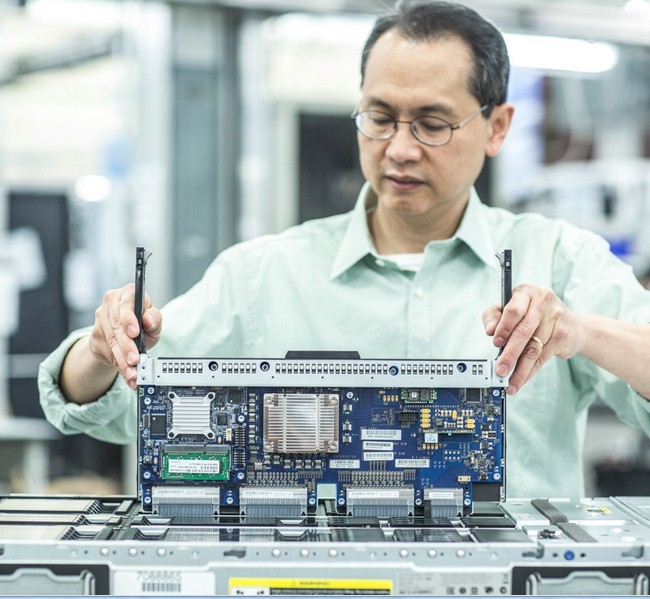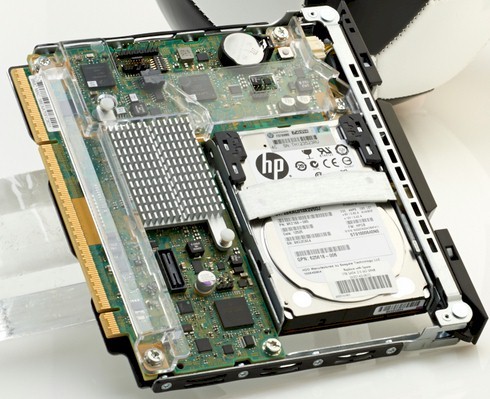This article is more than 1 year old
'Til heftier engines come aboard, HP Moonshot only about clouds
And those engines will come – as will FPGAs, DSPs, GPUs ...
A whole lotta options
The Moonshot 1500 chassis has two switch modules that run the length of the backplane, back to front. These are redundant Ethernet switches based on Broadcom Trident+ ASICs, so if you think HP cut a special deal with Intel for its Fulcrum Ethernet ASICs as well as for its Centerton Atoms (as I was expecting it to), you are wrong.
But that day will probably come. Gerald Kleyn, director of hyperscale server hardware R&D at HP, tells El Reg that the company is prepared to put all different kinds of switch fabrics at the heart of the Moonshot chassis – because it expects that as the computing in the chassis evolves, the networking needs will, too.
That could mean other Ethernet switch modules, or perhaps InfiniBand switches, if there is a demand for it. Kleyn is making no promises, except he says that HP is keeping an open mind and will add the networking features that customers require.

HP Moonshot switch module
The two Moonshot 45G Ethernet switch modules – known as A and B – are meant to be redundant for high availability and for load balancing, and together they provide an aggregate of 3.6Tb/sec of bandwidth. These Ethernet switch modules run at Gigabit Ethernet speeds, and each server cartridge can do four links to each of the two switches.
The chassis actually implements a bunch of different networks across the backplane, the switch modules, and the PCI-Express slots that are used to link the server cartridges to the chassis and to each other. The backplane also implements a 2D torus interconnect for linking server nodes in groups of three for so-called "north-south" direct links for an n-tier server architecture setup.
You can also use the 2D torus mesh implemented in the backplane to glue up to fifteen server nodes in an "east-west" configuration when the servers are sitting side-by-side and communicating (like in an infrastructure cloud, for instance, with virtual machines flitting around using live migration). This node-to-node 2D torus mesh offers 7.2 Tb/sec of bandwidth, which means you can link machines together with lots of oomph without having to rely on those Ethernet switches.
The backplane also implements a storage interconnect for linking to storage cartridges. These storage nodes, which are not yet available, will house two 2.5-inch disk drives in either 500GB or 1TB capacities; later this year, HP will make available a 200GB SATA flash drive option. (Why all of this is not available now is a mystery, and you have to figure that there are still some issues in the storage interconnect, which is derived from HP's SmartStorage disk controllers.)
Some of the pins on the PCI-Express slots in the Moonshot chassis are used to provide power to the server nodes, just as is done with the SeaMicro servers from Advanced Micro Devices and the Redstone servers based on the Calxeda ECX-1000 chips. There is also a separate management network to control the servers and storage, so you are not trying to ship application data and management data over the same network.
The Gemini Atom S1200 server node that is the first compute element to ship in the Moonshot servers is based on a dual-core, four-thread Atom S1260 processor running at 2GHz. It has 64KB of L1 data and 64KB of L1 instruction cache per core, plus 1MB of L2 cache memory shared across the cores.
The chip – technically a system on a chip – has a PCI-Express 2.0 controller and a DDR3 main memory controller. The memory, which is on a SO-DIMM on the side opposite the disk drive (which HP has not shown in any of its pictures), runs at 1.33GHz, has 8GB of capacity, and has ECC scrubbing, which is required by server operating systems.
The S1200 has VT electronics on the chip, as well, so it can run modern server virtualization hypervisors, too. The Gemini Atom server cartridge has a dual-port Broadcom 5270 Gigabit Ethernet port and a Marvell 9125 storage controller.

The Gemini Atom S1200 server node leaning on a soccer ball
At the moment Canonical's Ubuntu Server 12.04, Red Hat's Enterprise Linux 6.4, and SUSE Linux Enterprise Server 11 SP2 are supported on the Atom S1200 nodes. Support for Windows Server 2012 is expected in a few months, says Kleyn, but technically speaking, Windows Server 2012 will boot up on the node today. Support just means you can get tech support from Microsoft and HP when something goes wrong.
